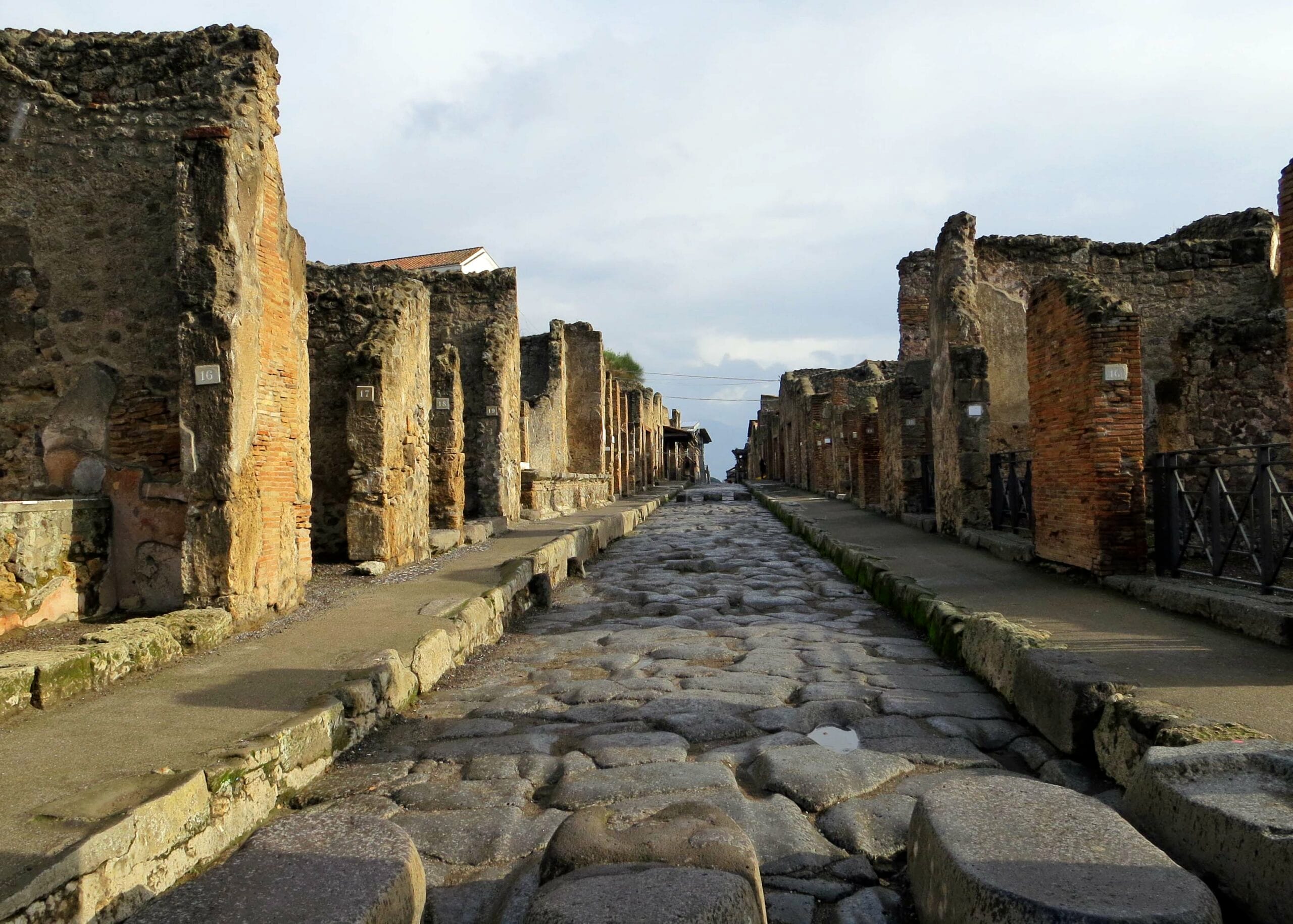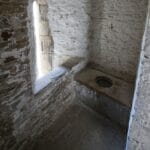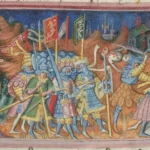Journey back in time to the tragic fate of Pompeii, where Mount Vesuvius’s fiery wrath froze life in an instant. These 25 haunting images paint a picture that’s both beautiful and heartbreaking, offering a glimpse into a vibrant city lost and serving as a sobering reminder of life’s fragility.
A Glimpse into a Lost World
Frozen in time, the city of Pompeii stands as a haunting yet strangely beautiful snapshot of life in the Roman Empire. Buried under a thick blanket of ash and pumice for centuries, the city’s rediscovery in the 18th century opened a window into the past, revealing the everyday details of a lost civilization.
Echoes of Life in the Ruins
Walking through the ruins, one can almost hear the echoes of Roman life. Vivid images of Pompeii depict a bustling city. Imagine vibrant marketplaces filled with vendors, the aroma of freshly baked bread, and neighbors catching up on the latest gossip. Intricate mosaics, frozen in place for centuries, decorate the floors of grand villas, offering a glimpse into the artistic tastes and social standings of Pompeii’s inhabitants.
The Terror of Vesuvius
Perhaps the most poignant images of Pompeii are those that capture the raw terror of the eruption. The plaster casts, meticulously created from the voids left by decomposed bodies, are both heartbreaking and eerily beautiful. Frozen expressions of fear etched on their faces serve as stark reminders of the fragility of life and the sheer power of nature’s fury.
Peeling Back the Layers of Time
Today, technology allows us to further unravel the mysteries of Pompeii. Aerial photography helps archaeologists grasp the city’s scale and layout, while 3D modeling breathes digital life into its buildings and streets. Each new discovery adds to our understanding of Pompeii’s culture, architecture, and the events leading up to its tragic end.
A Timeless Reminder
The images of Pompeii transcend their historical significance; they serve as a powerful reminder of the ephemeral nature of our own existence. They remind us that empires crumble, cities fall, and life, in all its vibrancy, can be extinguished in an instant. As we gaze upon these haunting images, we’re prompted to reflect on our own mortality, the legacy we’ll leave behind, and the importance of cherishing each fleeting moment.
How Many Human Remains Were Found at Pompeii?
The haunting plaster casts of Pompeii, created from the spaces left behind as bodies decayed in the volcanic ash, offer a glimpse into the city’s tragic end. However, these casts represent only a fraction of the individuals who perished. Archaeologists have discovered the skeletal remains of approximately 1,150 individuals in Pompeii, providing a broader understanding of the eruption’s devastating impact.
It is estimated that around 2,000 people lost their lives within Pompeii when Mount Vesuvius erupted in 79 AD. However, the devastation extended far beyond the city itself. Herculaneum and the surrounding areas were also severely affected, with some experts suggesting that the total death toll from the eruption could be as high as 16,000. The eruption effectively froze Pompeii in time, preserving not only human remains but also buildings, streets, and everyday objects, offering an incredibly rare and valuable window into the past.
Examining the skeletal remains from Pompeii has provided insights into various aspects of life, and death, in ancient Roman times. Scientists can glean information about the health, diet, and even the social status of Pompeii’s residents by studying their bones. For instance, analyzing the bones and teeth of the remains has revealed evidence of diseases like osteoarthritis and infections, as well as providing clues about their diet and occupations. The presence of pregnant women and children among the dead adds a deeply moving human element to the tragedy.
While the plaster casts, representing approximately 100 individuals, are iconic reminders of Pompeii’s fate, they only tell part of the story. New discoveries are continually being made as excavations continue, further deepening our understanding of the eruption’s impact. Advancements in technology, such as DNA analysis and 3D imaging, are helping researchers unlock even more secrets from Pompeii’s long-gone residents, painting a richer picture of life and death in this ancient city.
Why Do the Pompeii Bodies Look Like That?
When picturing the Pompeii bodies, one might imagine petrified remains frozen in time like statues. However, the truth is even more fascinating. When Mount Vesuvius erupted, it wasn’t just lava that engulfed Pompeii. The city was bombarded by super-heated gas and ash, which is what instantly killed most people. This rapid process preserved the outlines of their bodies in the hardened ash.
In the 1800s, archaeologist Giuseppe Fiorelli, while excavating Pompeii, noticed these empty spaces in the ash. He realized that they were the ghostly echoes of the victims. His ingenious solution was to inject plaster into those voids. The plaster would fill the space, harden, and reveal a detailed cast of the person. These casts capture their final posture, the folds in their clothes, and even the terrified expressions on their faces, serving as macabre time capsules.
It’s crucial to remember that these casts represent real people, not just statues. Some casts show parents desperately trying to shield their children, while others capture people clutching onto their valuables, offering poignant reflections of their last moments. These plaster casts aren’t just archaeological marvels; they provide a deeply human window into a tragedy.
Modern technology, such as 3D scanning, allows scientists to study the casts in even greater detail. This means that we can learn about their health, what they ate, and possibly even aspects of their lives by analyzing these casts. It’s like piecing together a puzzle, one scan at a time, to understand a lost civilization.
There’s still so much we don’t know about Pompeii and its people. However, with each new discovery and piece of evidence, we inch closer to understanding the human impact of that fateful day. The Pompeii casts are captivating because they remind us of the power of nature, the fragility of life, and the enduring strength of the human spirit.
What is the True Story of Pompeii?
While we know how Pompeii was lost, the exact events of that fateful day continue to fascinate us. Imagine a seemingly normal day in Pompeii – people going about their daily routines, shopkeepers selling their wares, children playing in the streets. They were unaware that Mount Vesuvius, looming large in the distance, was about to erupt with terrifying force.
While the exact amount of warning the people of Pompeii had remains uncertain, it’s clear that the eruption took many by surprise. It started with tremors that shook the ground. These tremors, likely dismissed as common occurrences in a region prone to seismic activity, were the first signs of the impending disaster.
Then, Vesuvius unleashed its fury. A massive column of ash and superheated gas shot miles into the atmosphere, darkening the sky and raining down pumice and ash on Pompeii. While terrifying, this ashfall probably didn’t cause immediate mass casualties. It was the pyroclastic flows, fast-moving currents of scorching gas and volcanic debris, that were truly deadly. Reaching temperatures of over 700 degrees Celsius (1,300 degrees Fahrenheit), the first of these flows would have been inescapable for many.
The speed and intensity of these pyroclastic flows meant that Pompeii was buried within a matter of hours. This rapid burial, while tragic, is the reason why the ruins of Pompeii are so well-preserved. The layers of ash and debris acted like a time capsule, protecting the city from the elements and preserving everyday objects, buildings, and even the forms of those who perished.
What we’ve learned from Pompeii goes beyond history books and archaeological digs. It offers a poignant reminder of the power of nature and the fragility of human existence. Even today, researchers are still uncovering the secrets of Pompeii, piecing together the lives of its inhabitants, and gaining a deeper understanding of this ancient tragedy.
Here is a spine-chilling account of a notorious torture device, the iron maiden torture, that strikes fear into the hearts of those who hear its name. Or, delve into the gruesome details of the iron maiden torture device.

















1 thought on “25 Haunting Images of Pompeii Frozen in Time”
Comments are closed.